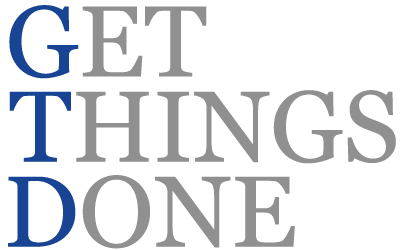Get Things Done (GTD)
When you delve into the time-management, organization subject, GTD comes up quickly. David Allen has created a legion of believers with his phenomenon concept.

Since then, additional concepts and expanded methods have been created, based off his core philosophy. I recently wrote on P.A.R.A. technique.
What exactly is the GTD way?
Charles Duhigg comments in his book, Smarter Faster Better, ” It’s about getting things done without sacrificing everything we care about along the way.”
On David Allen’s site, Getting Things Done, he defines it as “a personal productivity methodology that redefines how you approach your life and work”.
I would also add, it’s about prioritizing the important stuff, removing distractions and focusing on the essentials. In my weekly newsletter (Critical Thinking in a Crazy World), one of the core reality is ‘you cannot do it all’, and that is a flat out lie.

GTD at its core, helps you identify where everything goes. It’s truly an organization technique to place all items in their proper location for later retrieval.
The GTD Five Steps are:
- Collect (Capture)
- Process (Clarify)
- Organize
- Review (Reflect)
- Engage (Do)
Defining the GTD Five Steps
Collect (Capture)
Write, record, or gather any and everything that has your attention into a collection tool. Get everything out of your head onto some tangible surface, whether that is paper or digital.
Our minds, subconsicously, continues to remind us of things we need to do. When we push those thoughts onto a secure location (paper or digital), it breaks the open loop within our brain allowing us to be creative.
Process (Clarify)
Is it actionable? If so, decide the next action and project (if more than one action is required). If not, decide if it is trash, reference, or something to put on hold.
The process step moves our list to either actionable items, as a resource for later retrieval or trash it. This step is where you ‘label’ everything accordingly.
Organize
Park reminders of your categorized content in appropriate places. Once everything has been labeled (last step), we place those items in their proper location.
The point is putting it within its proper place. I view these two steps (process/organize) as cleaning our junk drawer.
We all have that junk drawer where everything is just thrown in, yet unable to locate anything. Clean it out and put those items in their proper place for easier retrieval.
Review (Reflect)
Update and review all pertinent system contents to regain control and focus.
This step allows you to keep checking on your content, ensuring it stays organized. Most will comment a weekly review. This allows you to clean up your lists, adjust items accordingly.
Let’s face it, life changes and our priorities also require adjustments. This step allows you to readjust accordingly.
Engage (Do)
Use your trusted system to make action decisions with confidence and clarity.
The key word here is ‘trusted.’ If you don’t trust your prior four steps, the brain will remain unclear. Trust me, I know. This is why it is important to trust whatever media you chose for the prior steps (paper, digital or hybrid).
Pulling it all together
Hopefully for those, who had not seen this before, grasped the fundamentals. There are multiple templates available for this overall method.

Matt Cole has high regard for knowledge share. He has a desire to share critical thinking and information. With a Masters in Information Technology and a wide array of certifications, while not working full-time, he wishes to knowledge share through providing insight, information organization, and critical thinking skills.
#KnowledgeShare | Matt Cole | #infobyMattCole



